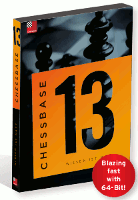Step by Step: Calculation #26
By Mark Donlan
Step by Step: Calculation is designed to improve your visualization and calculation skills. The premise is simple: find the winning move in the first diagram and then calculate the win from the second diagram and determine how it relates to the first. On ocassion follow-up questions will be asked relating to various sidelines. For best results, set the position up on the board and think for as long as you need without moving the pieces.
Black to move and win
![[FEN "8/5pk1/8/4p3/pp2Pn2/5P2/PP2B3/2Q3K1 b - - 0 38"]](https://chesscafe.com/wp-content/uploads/2014/10/sbscalc26a.gif)
[FEN “8/5pk1/8/4p3/pp2Pn2/5P2/PP2B3/2Q3K1 b – – 0 38”]
Calculate a win for Black
![[FEN "8/5pk1/8/4p3/pp1qPn2/5P2/PP2B3/2Q2K2 b - - 0 37"]](https://chesscafe.com/wp-content/uploads/2014/10/sbscalc26b.gif)
[FEN “8/5pk1/8/4p3/pp1qPn2/5P2/PP2B3/2Q2K2 b – – 0 37”]
Tolush,Alexander V – Simagin,Vladimir
URS-ch20 Moscow, 1952
Meran Semi-Slav [D47]
1.d4 d5 2.c4 c6 3.Nf3 Nf6 4.Nc3 e6 5.e3 Nbd7 6.Bd3 dxc4 7.Bxc4 b5 8.Bb3 b4 9.Ne2 Be7 10.0-0 0-0 11.Ng3 c5 12.e4 Bb7 13.Re1 cxd4 14.Nxd4 Ne5 15.Be3 Nfg4 16.Qe2 Nxe3 17.fxe3 Bh4 18.Qh5 Bxg3 19.hxg3 Ng6 20.Nf3 h6 21.Rad1 Qe7 22.Rd4 a5 23.Red1 Bc6 24.g4 a4 25.Bc4 Rfd8 26.g5 Bxe4 27.gxh6 Bxf3 28.gxf3 Rxd4 29.Rxd4 gxh6 30.Qxh6 Qf6 31.Kg2 Rd8 32.Rxd8+ Qxd8 33.e4 Qd4 34.Qc1 e5 35.Bb5 Nf4+ 36.Kf1 Kg7 37.Be2 (Diagram Two) 37…Qg1+ 38.Kxg1 (Diagram One) 38…Nxe2+ 39.Kf2Nxc1 0-1
Download Step By Step: Calculation #26 in PDF format.
All previous columns are available in the ChessCafe.com Archives.
Copyright 2014 Mark Donlan and ChessEdu.org. All Rights Reserved.

This is a very constructive and preferable way of teaching. Finding the winning move is one thing and knowing how we got there is quite another.